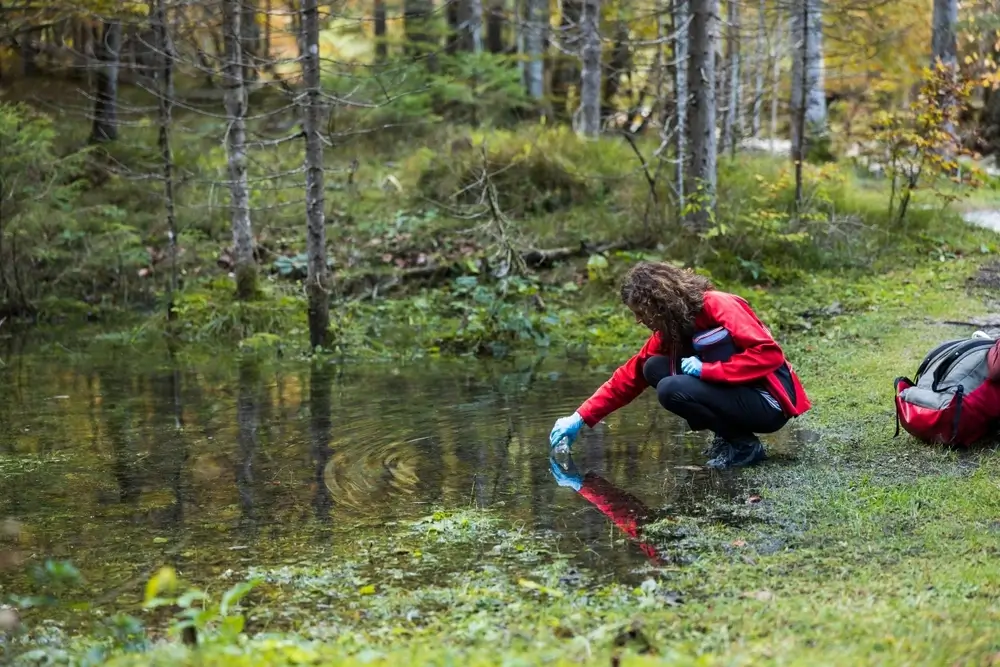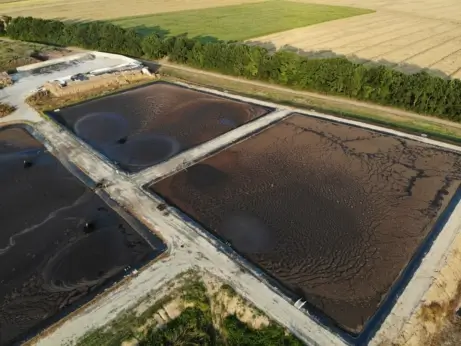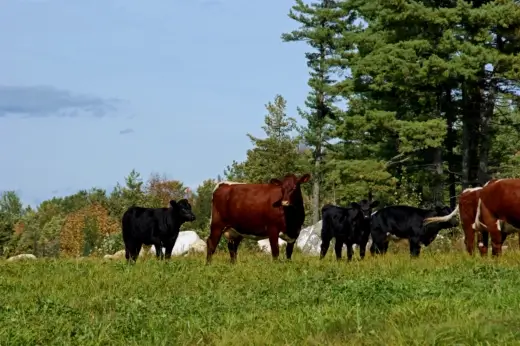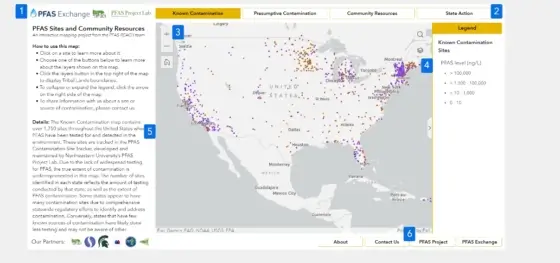On the Ground With Initiatives Responding to PFAS
Researchers and advocates around the world are looking for ways to help address the PFAS problem. Here is a quick look at some of these projects in their various stages of development.
On the Ground With Initiatives Responding to PFAS
Researchers and advocates around the world are looking for ways to help address the PFAS problem. Here is a quick look at some of these projects in their various stages of development.

Researchers are investigating possible future solutions to help address PFAS.by Shutterstock
They’re in the sewage sludge that farmers spread on fields as fertilizer, the pesticides used to control insects and the groundwater pumped for irrigation. They’re linked to health problems ranging from cancer to thyroid disease, and the U.S. Environmental Protection Agency has said no level of exposure to them is safe.
Perfluoroalkyl and polyfluoroalkyl substances, the class of chemicals more commonly known as PFAS, are everywhere, not just in the world of agriculture. Since the 1940s, chemical companies such as Chemours, DuPont and 3M have developed more than 14,000 PFAS compounds for use in products as varied as nonstick cookware, electric-vehicle batteries and refrigerators. Because all PFAS contain bonds between carbon and fluorine, among the hardest to break in chemistry, they’ve earned the moniker “forever chemicals” for their remarkable persistence in the environment.
The problems with PFAS are daunting, but people are now mobilizing to reduce the dangers they pose. At the federal level, the EPA recently enacted its first enforceable limits for six PFAS in drinking water, as well as placed two PFAS on the list of hazardous substances covered by the Superfund law. And in communities across the country, researchers and local officials are testing out innovative approaches.

Beth Valentine’s inaugural fund
The leading edge of state-level responses to agricultural PFAS can be found in Maine. In 2022, its legislature became the first in the US to ban the field spreading of PFAS-containing sludge, and earlier this year, its Department of Agriculture, Conservation and Forestry opened applications for the country’s first fund to help farmers deal with PFAS pollution on their land—with $65 million allocated so far.
“There are still many unknowns concerning how PFAS travel through [different substances] and to what extent they are taken up in various food products,” says Beth Valentine, the fund’s director. Because of this uncertainty, Valentine says farmers need time to identify and implement strategies to deal with PFAS.

The bulk of the fund will give farmers financial and technical backing as they plan for changes in their business. About $20 million is also set aside to purchase and manage land that’s too contaminated to work, with the goal of eventually making it suitable for farming again.
While the fund’s initial allocation is expected to last for five years, Valentine says it will seek additional money from state and federal governments, as well as through litigation against PFAS manufacturers, for ongoing operation. “PFAS are nicknamed ‘forever chemicals,’” she say. “Agricultural producers are likely to need support for years to come.”
Jessica Ray’s selective carbon
Scientists know that one widely available technology is pretty good at removing PFAS: activated carbon, a processed charcoal that captures chemicals in countless tiny pores. The issue, says civil and environmental engineer Jessica Ray with the University of Washington, is that activated carbon is even better at removing everything else.
Because PFAS chemicals are usually present at much lower concentrations in wastewater than other pollutants such as drugs and pesticides, Ray explains, those more common contaminants can fill up activated carbon’s filtration capacity first. She and her colleagues have thus been working on a way to make carbon choosier.
Ray describes her approach as “kind of a lock-and-key mechanism for PFAS removal, where we’re building the lock and the PFAS molecule is the key.” She allows a reusable plastic polymer to form around a specific PFAS in the lab, then washes away the chemical, leaving behind microscopic impressions in the polymer like footprints in wet concrete. When the polymer is joined to activated carbon, its tailor-made molecular slots filter out PFAS while snubbing other pollutants.
After proving the concept in a paper published last year, Ray hopes to develop a polymer that targets the six PFAS the EPA now regulates in drinking water. That solution could then be layered atop existing activated carbon filters, making it easier to adopt at scale.

Susie Dai’s friendly fungi
“Human beings are good at producing many new problems,” says Susie Dai about the spread of PFAS. As the associate professor of environmental sciences at Texas A&M University points out, however, the most pernicious part of PFAS chemistry—the “forever” carbon-fluorine bond—is also produced in nature, as part of the toxins made by a handful of mostly tropical plants.
Since those bonds are mirrored in nature, a natural solution also exists to break them, through the decomposing powers of bacteria and fungi. As described in a 2022 paper, Dai’s team took corn harvest wastes and processed them into a material that both filtered PFAS from wastewater and provided a substrate for Irpex lacteus, a fungus also called white rot, which is typically found on hardwoods. After adding PFAS to the medium and letting the fungus grow for two weeks, Dai confirmed that it had started to break down the pollutants.
But the process needs to happen at a much greater scale and speed to deal with the ubiquitous PFAS pollution introduced by humanity. Going forward, Dai plans to study the biological mechanisms white rot uses to destroy PFAS, with the goal of picking up the pace. “We’re adding an acceleration pedal,” she says.
An online community
Today, nearly all Americans have measurable PFAS levels in their blood.
“We’ve all been signed up for the study without our consent,” says Laurel Schaider, PhD, senior scientist at the Silent Spring Institute, a nonprofit research organization dedicated to understanding the links between chemical exposures and health. “We’re all part of this.”
PFAS-REACH (Research, Education and Action for Community Health) is a collaboration between research partners Silent Spring Institute, Northeastern University and Michigan State University, and community partners Testing for Pease, Slingshot and the Massachusetts Breast Cancer Coalition. The initiative has developed the PFAS Exchange, a free resource for communities affected by PFAS and anyone who wants to learn more about the chemicals.

Among the site’s resources is the Connecting Communities map, led by the PFAS Project Lab. The map is an ArcGIS tool that allows people to see locations of known PFAS contamination, sites of presumed contamination, which states have passed PFAS regulations and conducted testing, locations of health and exposure studies as well as regional advocacy with whom people can connect.
PFAS Exchange also features the What’s My Exposure? tool. This is for people who have had their water or blood tested for PFAS. Schaider says it’s important to give people not only results but also enough context to understand what those results mean. The What’s My Exposure? tool allows people to enter in their test results and see how they compare to other people and areas.
“They can understand what their results mean—as well as anyone can—and they feel empowered to take action.”
This story is part of our ongoing PFAS series, The PFAS Problem: Demystifying ‘Forever Chemicals’
Follow us
This work is licensed under a Creative Commons Attribution-NoDerivatives 4.0 International License.
Want to republish a Modern Farmer story?
We are happy for Modern Farmer stories to be shared, and encourage you to republish our articles for your audience. When doing so, we ask that you follow these guidelines:
Please credit us and our writers
For the author byline, please use “Author Name, Modern Farmer.” At the top of our stories, if on the web, please include this text and link: “This story was originally published by Modern Farmer.”
Please make sure to include a link back to either our home page or the article URL.
At the bottom of the story, please include the following text:
“Modern Farmer is a nonprofit initiative dedicated to raising awareness and catalyzing action at the intersection of food, agriculture, and society. Read more at <link>Modern Farmer</link>.”
Use our widget
We’d like to be able to track our stories, so we ask that if you republish our content, you do so using our widget (located on the left hand side of the article). The HTML code has a built-in tracker that tells us the data and domain where the story was published, as well as view counts.
Check the image requirements
It’s your responsibility to confirm you're licensed to republish images in our articles. Some images, such as those from commercial providers, don't allow their images to be republished without permission or payment. Copyright terms are generally listed in the image caption and attribution. You are welcome to omit our images or substitute with your own. Charts and interactive graphics follow the same rules.
Don’t change too much. Or, ask us first.
Articles must be republished in their entirety. It’s okay to change references to time (“today” to “yesterday”) or location (“Iowa City, IA” to “here”). But please keep everything else the same.
If you feel strongly that a more material edit needs to be made, get in touch with us at [email protected]. We’re happy to discuss it with the original author, but we must have prior approval for changes before publication.
Special cases
Extracts. You may run the first few lines or paragraphs of the article and then say: “Read the full article at Modern Farmer” with a link back to the original article.
Quotes. You may quote authors provided you include a link back to the article URL.
Translations. These require writer approval. To inquire about translation of a Modern Farmer article, contact us at [email protected]
Signed consent / copyright release forms. These are not required, provided you are following these guidelines.
Print. Articles can be republished in print under these same rules, with the exception that you do not need to include the links.
Tag us
When sharing the story on social media, please tag us using the following: - Twitter (@ModFarm) - Facebook (@ModernFarmerMedia) - Instagram (@modfarm)
Use our content respectfully
Modern Farmer is a nonprofit and as such we share our content for free and in good faith in order to reach new audiences. Respectfully,
No selling ads against our stories. It’s okay to put our stories on pages with ads.
Don’t republish our material wholesale, or automatically; you need to select stories to be republished individually.
You have no rights to sell, license, syndicate, or otherwise represent yourself as the authorized owner of our material to any third parties. This means that you cannot actively publish or submit our work for syndication to third party platforms or apps like Apple News or Google News. We understand that publishers cannot fully control when certain third parties automatically summarize or crawl content from publishers’ own sites.
Keep in touch
We want to hear from you if you love Modern Farmer content, have a collaboration idea, or anything else to share. As a nonprofit outlet, we work in service of our community and are always open to comments, feedback, and ideas. Contact us at [email protected].by Daniel Walton, Modern Farmer
June 18, 2024
Modern Farmer Weekly
Solutions Hub
Innovations, ideas and inspiration. Actionable solutions for a resilient food system.
ExploreShare With Us
We want to hear from Modern Farmer readers who have thoughtful commentary, actionable solutions, or helpful ideas to share.
SubmitNecessary cookies are absolutely essential for the website to function properly. This category only includes cookies that ensures basic functionalities and security features of the website. These cookies do not store any personal information.
Any cookies that may not be particularly necessary for the website to function and are used specifically to collect user personal data via analytics, ads, other embedded contents are termed as non-necessary cookies.